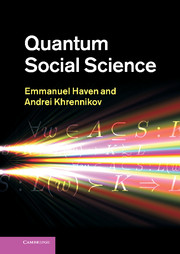Book contents
- Frontmatter
- Dedication
- Contents
- Foreword
- Preface
- Acknowledgements
- List of symbols
- I Physics concepts in social science? A discussion
- 1 Classical, statistical, and quantum mechanics: all in one
- 2 Econophysics: statistical physics and social science
- 3 Quantum social science: a non-mathematical motivation
- II Mathematics and physics preliminaries
- III Quantum probabilistic effects in psychology: basic questions and answers
- IV Other quantum probabilistic effects in economics, finance, and brain sciences
- Glossary of mathematics, physics, and economics/finance terms
- Index
3 - Quantum social science: a non-mathematical motivation
from I - Physics concepts in social science? A discussion
Published online by Cambridge University Press: 05 July 2013
- Frontmatter
- Dedication
- Contents
- Foreword
- Preface
- Acknowledgements
- List of symbols
- I Physics concepts in social science? A discussion
- 1 Classical, statistical, and quantum mechanics: all in one
- 2 Econophysics: statistical physics and social science
- 3 Quantum social science: a non-mathematical motivation
- II Mathematics and physics preliminaries
- III Quantum probabilistic effects in psychology: basic questions and answers
- IV Other quantum probabilistic effects in economics, finance, and brain sciences
- Glossary of mathematics, physics, and economics/finance terms
- Index
Summary
What is quantum social science?
After a short discursion into the field of “econophysics” we now arrive at a much more exotic stop. However, readers who have perused Chapter 1, will possibly be less astonished to find that instead of making reference to social science within a statistical mechanics environment, we now make reference to social science as it could be embedded in a quantum mechanical context. Or is “quantum social science” denoting something altogether different? The term is certainly fraught with a huge potential for misinterpretation. A common, but maybe not so erroneous, interpretation of the term often made by newcomers to this “field” can be expressed via the following question: “is quantum social science about reformulating social science with quantum mechanical tools?” Such a question brings us closer to the goal of attempting to explain quantum social science, but right here and now, i.e. at this very point in this book, we have the opportunity to make a serious attempt to be really precise on what is meant with this new term.
Therefore, let us from the outset indicate what it is not. Quantum social science is not about reformulating social science on a quantum size scale. The macroscopic world does not operate at the Planck scale. On prima facie, this obvious statement does not need any further explanation. However, if the human experience is centered around consciousness and the functioning of the brain, then we are much less sure to claim there is a total absence of quantum processes.
- Type
- Chapter
- Information
- Quantum Social Science , pp. 54 - 68Publisher: Cambridge University PressPrint publication year: 2013



